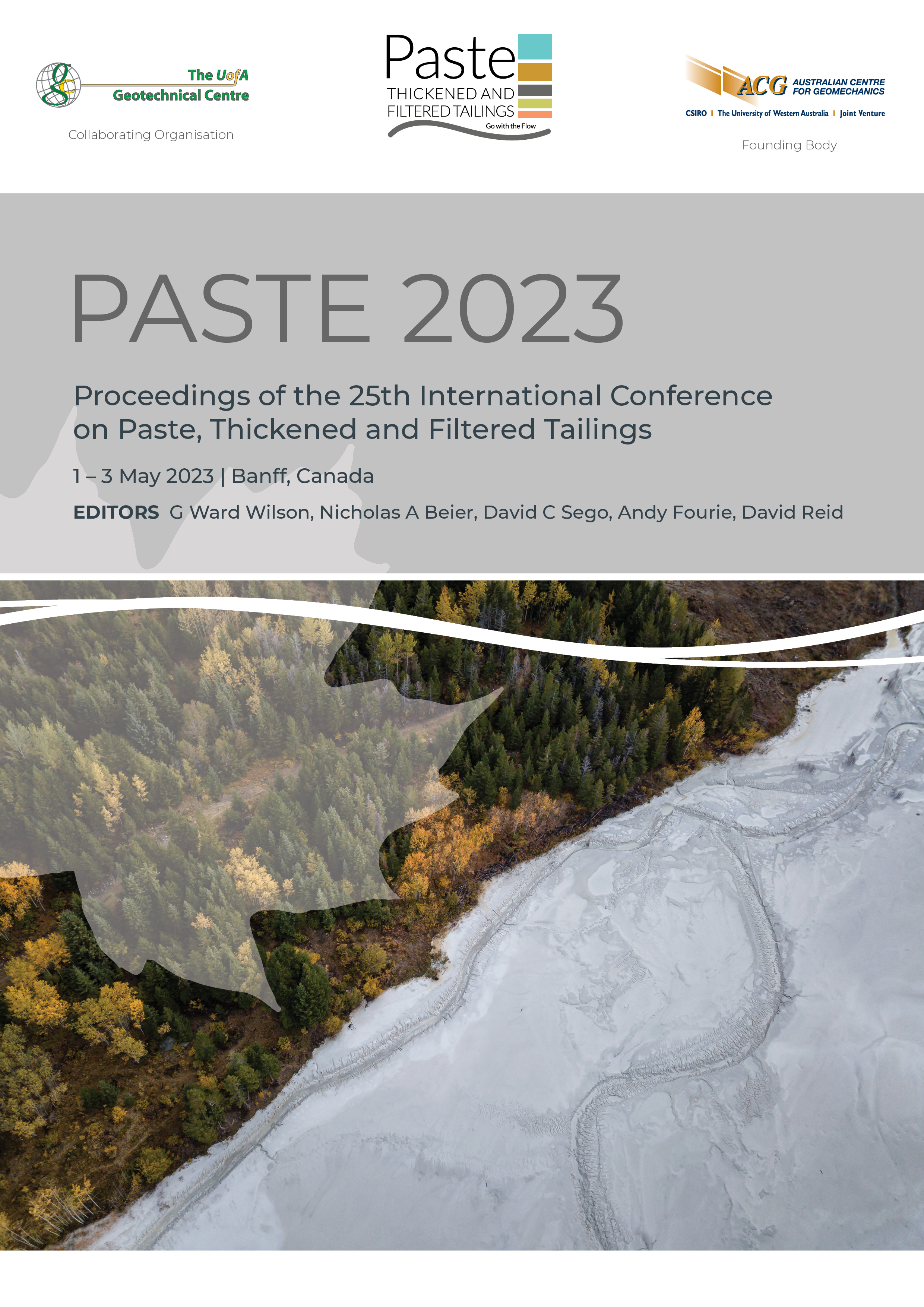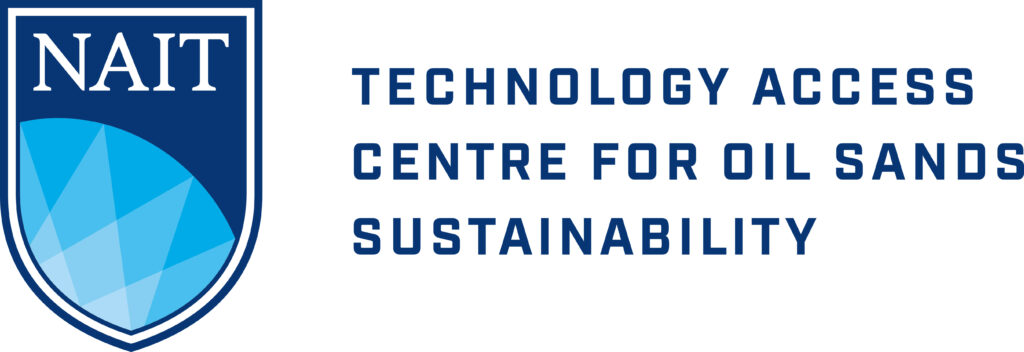Backfilling in the permafrost: predicting pressure loss and temperature distribution along the paste backfill pipeline system

|
Authors: Kalonji, K; Mbonimpa, M; Belem, T; Ouellet, S; Gélinas, LP |
DOI https://doi.org/10.36487/ACG_repo/2355_16
Cite As:
Kalonji, K, Mbonimpa, M, Belem, T, Ouellet, S & Gélinas, LP 2023, 'Backfilling in the permafrost: predicting pressure loss and temperature distribution along the paste backfill pipeline system', in GW Wilson, NA Beier, DC Sego, AB Fourie & D Reid (eds), Paste 2023: Proceedings of the 25th International Conference on Paste, Thickened and Filtered Tailings, Australian Centre for Geomechanics, Perth, pp. 220-232, https://doi.org/10.36487/ACG_repo/2355_16
Abstract:
Underground mine backfilling of permafrost open stopes with cemented paste backfill (CPB) has many challenges to overcome, including keeping the CPB unfrozen during pipeline transportation at low pumping costs and ensuring the required strength development under sub-zero temperature conditions. However, CPB strength development depends strongly on the evolution of its internal curing temperature that, in turn, is controlled by the CPB placement temperature (initial) in the stope and by the permafrost boundary temperature. Hence, it is relevant to predict the required pumping pressure and distribution of the CPB temperature along the pipeline by considering the internal and external heat exchanges and the thermorheological behaviour of the CPB. The objective of this paper is to simulate the CPB pipe flow in a fullscale pipeline distribution network anticipated for a mine located in the permafrost region of the north of Canada. For that purpose, CPB mixtures were prepared at 10°C (initial temperature expected in the backfill plant) in the laboratory with 5% of type HE Portland cement at a slump height of about 17.8 cm (corresponding to a solid concentration of about 76.3 %). The numerical simulations were performed using the non-isothermal pipe flow model of COMSOL Multiphysics® 5.2 considering a distribution network of approximately 1,600 m long that includes an outdoor section of approximately 294 m exposed to air circulating at a speed of 1 m/s and to an extreme temperature of -50°C. The permafrost temperature was taken to be -5°C. Unheated (at -5°C) and heated (at +2°C) underground openings were studied. A CPB flow velocity of 1.04 m/s and a pipe diameter of 0.1463 m were considered, as proposed by the owner of the mine project. Results indicate that the total pumping pressure is about 12 MPa (heated and unheated stopes) and the pressure gradient (𝛥𝑝/𝐿) distribution along the horizontal pipeline sections is about 13 kPa/m. A decrease in the CPB temperature was observed in the surface section, followed by an increase in the underground sections. This temperature increase can be explained by the predominance of heat transfer by convection rather than radial conduction of the heat generated by viscous dissipation. The effect of a thermal insulation of the pipeline section at the surface was also studied for comparison purposes.
Keywords: cemented paste backfill, permafrost, heat exchange, pumping pressure, pressure gradient, sub-zero temperature, temperature distribution
References:
Alves, MA, Baptista, A & Coelho PM 2015, ‘Simplified method for estimating heat transfer coefficients: constant wall temperature case’, Heat Mass Transfer, vol. 51, pp. 1041–1047,
Assefa, KM & Kaushal, DR 2015, ‘A comparative study of friction factor correlations for high concentrate slurry flow in smooth pipes’, Journal of Hydrology and Hydromechanics, vol. 63, pp. 13–20,
Belem, T & Benzaazoua, M 2003, ‘Utilisation du remblai en pâte comme support de terrain. Partie I : de sa fabrication à sa mise en place sous terre’, Après-mines 2003.
Beya, FK, Mbonimpa, M, Belem, T, Li, L, Marceau, U, Kalonji, PK, Benzaazoua, M & Ouellet, S 2019, ‘Mine backfilling in the permafrost, part I: Numerical prediction of thermal curing conditions within the cemented paste backfill matrix’, Minerals, vol. 9,
Bird, RB, Stewart, EW & Lightfoot EN 2002, Transport Phenomena, 2nd edn, John Wiley and Sons, Inc., New York.
Brackebusch, FW 1994, ‘Basics of paste backfill systems’, Mining Engineering, vol. 46, pp. 1175–1178,
COMSOL 2012, COMSOL Multiphysics Reference Manual, COMSOL, Burlington, p. 750.
Cooke, R, Spearing, A & Gericke D 1992, ‘The influence of binder addition on the hydraulic transport of classified tailings backfills’, Journal of the Southern African Institute of Mining and Metallurgy, vol. 92, pp. 325–329.
Cruz, DA, Coelho, PM & Alves, MA 2012, ‘A simplified method for calculating heat transfer coefficients and friction factors in laminar pipe flow of Non-Newtonian fluids’, ASME Journal of Heat and Mass Transfer, vol. 134, no. 9,
Cui, L & Fall, M 2016, ‘Mechanical and thermal properties of cemented tailings materials at early ages: Influence of initial temperature, curing stress and drainage conditions’, Construction and Building Materials, vol. 125, pp. 553–563,
Dehkordi, AM & Memari, M 2010, ‘Transient and steady-state forced convection to power-law fluids in the thermal entrance region of circular ducts: Effects of viscous dissipation, variable viscosity, and axial conduction’, Energy Conversion and Management, vol. 51, pp. 1065–1074,
Farshad, F, Rieke, H & Garber, J 2001, ‘New developments in surface roughness measurements, characterization, and modeling fluid flow in pipe’, Journal of Petroleum Science and Engineering, vol. 29, no. 2, pp. 139–150,
Ferrouillat, S, Bontemps, A, Ribeiro, J-P, Gruss, J-A & Soriano, O 2011, ‘Hydraulic and heat transfer study of SiO2/water nanofluids in horizontal tubes with imposed wall temperature boundary conditions’, International Journal of Heat and Fluid Flow, vol. 32, pp. 424–439.
Incropera, FP, Dewitt, DP, Bergman, TL, & Lavine, AS 2007, Fundamentals of Heat and Mass transfer, 6th edn, John Wiley & Son Inc., New York.
Kalonji, K, Mbonimpa, M, Belem, T, Benzaazoua, M, Beya, F & Ouellet, S 2015, ‘Preliminary investigation of the effect of temperature and salinity on the rheological properties of fresh cemented paste backfills’, Proceedings of Canadian Geotechnical Conference, GeoQuebec 2015: Challenges from North to South, Canadian Geotechnical Society.
Mbonimpa, M, Kwizera, P & Belem, T 2019, ‘Mine backfilling in the permafrost, part II: Effect of declining curing temperature on the short-term unconfined compressive strength of cemented paste backfills’, Minerals, vol. 9, no. 3,
10.3390/min9030172
Swamee, PK & Aggarwal, N 2011, ‘Explicit equations for laminar flow of Bingham plastic fluids’, Journal of Petroleum Science and Engineering, vol. 76, pp. 178–184,
Taylor, JB, Carrano, AL & Kandlikar, SG 2006, ‘Characterization of the effect of surface roughness and texture on fluid flow—past, present, and future’, International Journal of Thermal Sciences, vol. 45, pp. 962–968,
Tseng, C, Yamaguchit, M & Ohmorit, T 1997, ‘Thermal conductivity of polyurethane foams from room temperature to 20 K’, Cryogenics, vol. 37, pp. 305–312.
Winter, HH 1987, ‘Viscous dissipation term in energy equations’, American Institute of Chemical Engineers, vol. 7, pp. 27–34.
© Copyright 2025, Australian Centre for Geomechanics (ACG), The University of Western Australia. All rights reserved.
View copyright/legal information
Please direct any queries or error reports to repository-acg@uwa.edu.au
View copyright/legal information
Please direct any queries or error reports to repository-acg@uwa.edu.au



